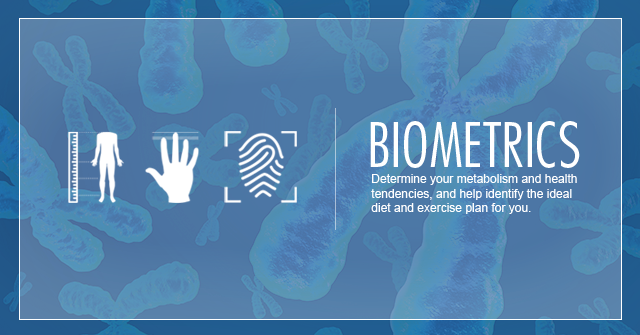
Biometrics is the measuring and analysing of human body characteristics. Some high-tech security systems, such as retina scanners or fingerprint ID, use biometrics. It can also be used to determine your metabolism and health tendencies, which can help identify the ideal diet and exercise plan for you. We all start out with genes from our parents, which is genetics. But that’s only half the story. How those genes react to our environment is known as epigenetics. For example,you may have inherited a tendency for diabetes or heart disease, but these genes can be “turned on” or “silenced.” By the time you’re born, a lot of these patterns have been set.
Your cells are constantly replicating, and each time they do, the basic genetic pattern is copied exactly. But which genes are “turned on” and which ones are “silenced” can change each time a cell is copied. That means that your diet, exercise, and stress levels can change long-standing patterns.
Biometrics can identify epigenetic patterns. One example is the Agouti mouse. Some of these mice are born overweight, have a tendency towards diabetes, and have golden fur. If the mother mouse is fed a better diet while pregnant, she’ll give birth to a normal weight mouse with brown fur. There’s no particular reason that fur colour and weight should be related, but the genes for those two tendencies happen to be close together. You can look at a pup and know whether or not it’s prone to diabetes just from the color of its fur.
Similarly, we can tell a lot about a person’s metabolism and health tendencies based on leg length, fingerprints, and other apparently random measurements. Many things in the prenatal environment can cause a health tendency AND a measurable difference in the body, because they developed around the same time. Various measurements are used in the GenoType Diet® to help determine which of 6 GenoTypes you best fit into (Hunter, Gatherer, Teacher, Explorer, Warrior or Nomad).
|
|
Leg length is measured in two ways. First, the total leg length is compared to the length of the torso. Secondly, the upper leg is compared to the length of the lower leg. Both of these ratios reflect the amount of growth factors you were exposed to in the womb. This affects the risk of diabetes, heart disease, and cancer. |
|
|
Finger lengths reflect the prenatal exposure to sex hormones. Longer ring fingers means you were exposed to more androgens (male sex hormones) and longer index fingers means you were exposed to more estrogens (female sex hormones) while in the womb. The amount of space between your thighs and knees when you stand with your ankles together also reflects prenatal hormone exposure. More gaps reflect “male” tendencies, while more touching reflects more “female” tendencies, regardless of your actual sex. This is a reflection of how your body was put together, and helps to figure out which GenoType best describes you. It’s not about how “manly” or “feminine” you are. |
|
|
Fingerprints develop between 6 and 21 weeks of gestation, so fingerprint patterns reflect the prenatal environment for that whole time. There are 3 major patterns found in fingerprints, known as whorls, arches, and ulnar loops. Having 3 or more arches is linked to sluggish digestion, 6 or more whorls indicates a higher risk of breast cancer, and 8 or more ulnar loops is linked to higher rates of Alzheimer’s disease and cognitive decline. Symmetry in fingerprints is also important- whether the patterns on both index fingers, both pinkies, etc are the same or different. |
Asymmetry can be found in other measurements as well, such as having a longer ring finger on one hand and a longer index finger on the other, or a longer upper leg on one side and a longer lower leg on the other. This reflects prenatal stress. The two sides of a baby develop independently, but usually along the same lines. Stress may interfere with development on one side only, creating asymmetry. Some GenoTypes are categorised by more symmetry than others.There are other measurements that can help refine your GenoType, and these can be found on pages 46 through 84 of Change Your Genetic Destiny. Dietary and exercise guidelines for each GenoType are outlined in that book as well. SWAMI GenoTyping also uses these biometrics, to compute a diet and exercise guideline just for you.
Peter J. D'Adamo, ND, MIFHI
Peter D'Adamo is a distinguished professor of clinical sciences at the University of Bridgeport College of Naturopathic Medicine, USA, a naturopathic physician, author, researcher-educator, Ivesian, software developer and air-cooled enthusiast. He is a recognised authority in glycobiology, particularly the ABO blood groups and the secretor (FUT2) polymorphisms. He is versant in several computer languages, with SWAMI (serotyping with advanced modifiable inventories) and OPUS23 just two of his software applications currently in use.
Dr D'Adamo teaches Generative Medicine I and II, Introduction to Biochemical Individuality of Naturopathic Medicine, and supervises a specialised clinic shift in Personalised Medicine at the University of Bridgeport. He has published the first textbook in naturopathic systems biology, Fundamentals of Generative Medicine, Vol. 1 (Drum Hill Publishing, LLC).
He is the author of several popular books, all of which can be found by clicking here including the New York Times bestseller, Eat Right for Your Type (Penguin Putman) and most recently Change Your Genetic Destiny (Random House).
Paul Hopfensperger, MIFHI, MCMA
Paul Hopfensperger is a UK based Master Instructor for Dr. Peter J D'Adamo's Institute for Human Individuality at Body and Mind Studio®. He specialises in The Blood Type Diet®, The GenoType Diet® and OPUS23 Genomic Bioinformatics.







